ASUS PA246Q 24" ProArt Monitor: No Adjustments Needed?
by Chris Heinonen on July 2, 2012 1:30 PM ESTASUS PA246Q - Display Uniformity
The large viewing angles allowed by an IPS panel only truly help if colors are accurate at the edges of the screen and not just in the center. On the PA246Q the lower-left of the panel seems to be brighter than the rest of it, as it is close to the same level as the center of the screen but the right and top sides of the panel are a bit dimmer. Even with those sides being dimmer, that is better than most displays where all sides are dimmer instead of just 50% of them. So white uniformity is better than average, but not perfect.
Black uniformity shows the same pattern, only in this case as the lower-left is brighter, it has worse performance that the upper right. If these black levels look worse than the previous black levels we discussed, these are set with the backlight at the level needed for 200 nits of white, which was around 40 brightness on this display.
Because I have the data, I added another chart this time, Contrast Uniformity. This simply takes the previous two charts and shows the relative contrast across the screen. Surprisingly the worst contrast was in the dead center of the display, so perhaps if I were to go back and do this chart for other displays I would find the contrast number we use is a worst-case-scenario. In any case, I plan to use this going forward as well since we already have the data, and we can see how close the contrast ratio is across the screen. Here the standard deviation is only 4.26%, which is lower than both the white and black uniformity deviations. So if you are dimmer in white, you’ll be darker in black by a comparable degree it seems.
Finally we can look at the dE uniformity of the PA246Q. Broken down by color the dE values are close for the most part, though the lower-left section of the screen is clearly way off on the grayscale and in most other colors relative to the rest of the screen. Surprisingly the center-bottom of the screen outperforms the center, which is what we calibrate to as our target, which is a bit strange. The average deviation for each sample is almost half a dE, which is a pretty large deviation when you consider that the average dE is right around 2. Overall the PA246Q seems mostly uniform, but with a couple outliers here that tend to skew the data.
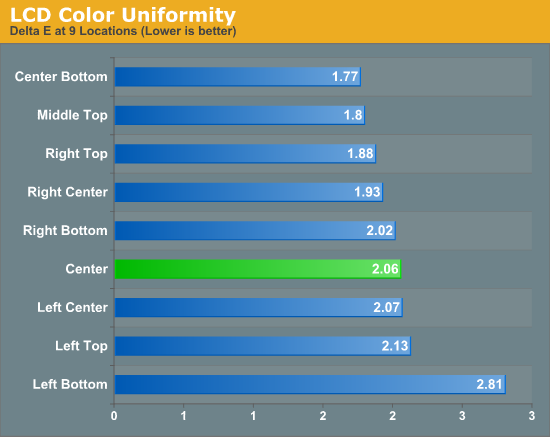


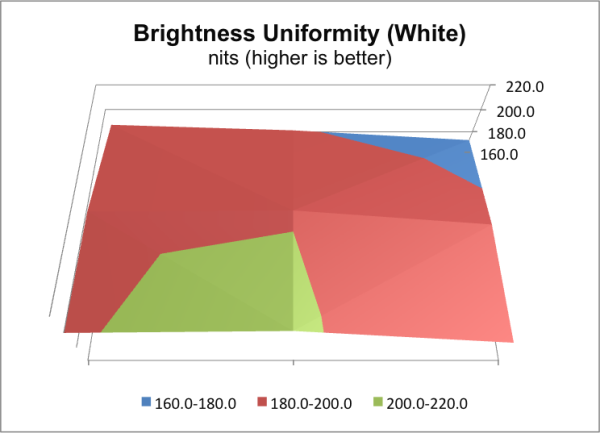
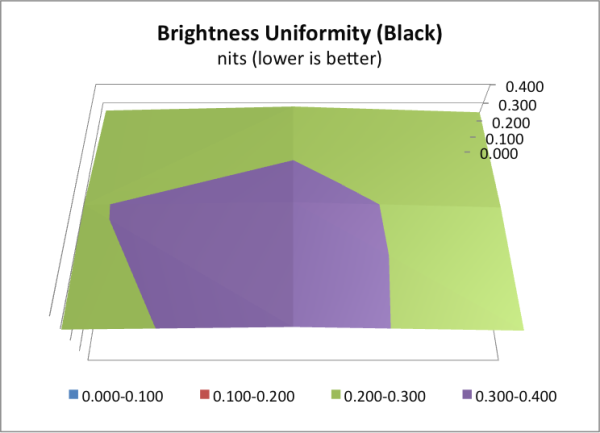
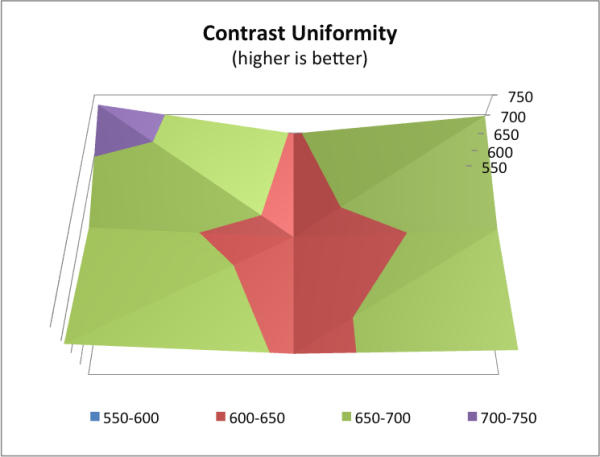
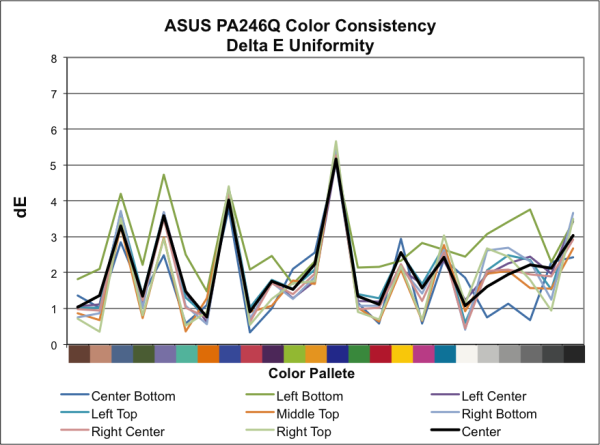
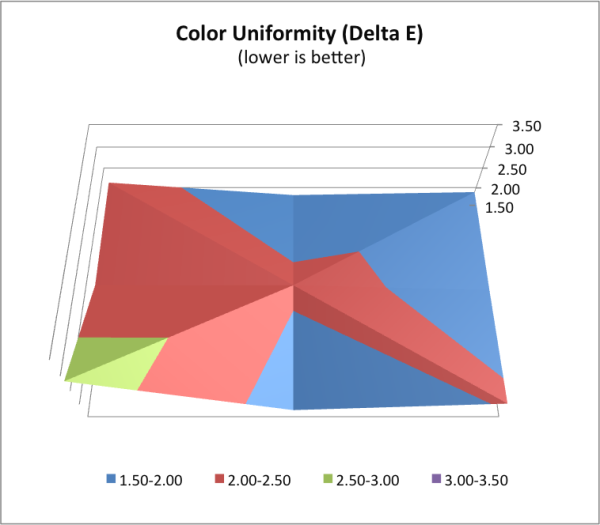








52 Comments
View All Comments
cheinonen - Tuesday, July 3, 2012 - link
Anand did a quick look at one last month and some numbers on it. As mentioned, they're import units that are going to be lacking much of a warranty or dead pixel replacement or anything else. They also all seem to lack DisplayPort inputs (DVI only), any sort of adjustable stand, much of an OSD or control beyond brightness, and use panels that aren't quite as high grade as the main manufacturers, which is how they get the costs down to this.Unfortunately it's beyond my means to go buy everything for review, even if it is a $350 unit, and I do have serious reservations myself when thinking about recommending a unit that will lack a warranty or much ability to exchange it for a new one in case it is defective.
Zoomer - Wednesday, July 4, 2012 - link
It's A- instead of A+. And there's no point in a "pixel perfect" screen; extra money is being paid for nothing. They are rated A- for a reason.The boards convert DVI to eDP internally, so DP support might be possible with a little hacking.
Credit card warranty should cover these monitors, and risk of defective units can be mitigated through the same.
madmilk - Tuesday, July 3, 2012 - link
http://www.anandtech.com/Show/Index/5885?cPage=2&a...It's not really a full review, but it has the important stuff.
jabber - Tuesday, July 3, 2012 - link
...just a shame it looks like it came from 2003.Sunny129 - Tuesday, July 3, 2012 - link
Chris,Is the Dell U2410 on your list of displays to test? I would love to see a review of a display that directly competes w/ the ASUS PA246Q, namely the Dell U2410. You're already reviewed the Dell U 2412M, so if you choose to review the ASUS PA248Q in the future, there's already a Dell U2412M review to compare it to. the ASUS PA246Q on the other hand is the only display of its kind to be reviewed here yet (to my knowledge), and so we need another review of a display that's as much of an apples-to-apples comparison as possible (something w/ at least a true 8-bit panel, 1920 x 1200 res, ~$500 price range, etc).
Thanks,
Eric
Makaveli - Tuesday, July 3, 2012 - link
If they are going to review a U2410 which is a few years old now, they would also need to review the HP ZR24w both are IPS and real 8 bit panels compared to the 6 bit e-ips panel in the U2412m. i'm not sure what panel the replacement for the ZR24w is using only that its an LED panel, so people have complained about poorer blacks.cheinonen - Tuesday, July 3, 2012 - link
Dell doesn't have a U2410 available for me to review, which leads me to think we might see a replacement for it in the near future. I asked but couldn't get one.xKeGSx - Tuesday, July 3, 2012 - link
Any word on the 27" variants of this monitor. Being the ProArt PA278Q and the non-calibrated and missing USB 3.0 ports VA278Q? Thanks Been reading for over 10 years now. Keep it up!DeathBooger - Tuesday, July 3, 2012 - link
I have two of these monitors. When I got them, one had a blue tint and the other had a red tint. Both cleaned up fine once I properly calibrated them with my Datacolor Spyder. They match up just fine once calibrated.Leyawiin - Wednesday, July 4, 2012 - link
http://www.newegg.com/Product/Product.aspx?Item=N8...Other than a few minor changes they're practically the same monitor...only the PA248Q is much cheaper and has slightly better contrast.
http://www.digitalversus.com/lcd-monitor/asus-pa24...